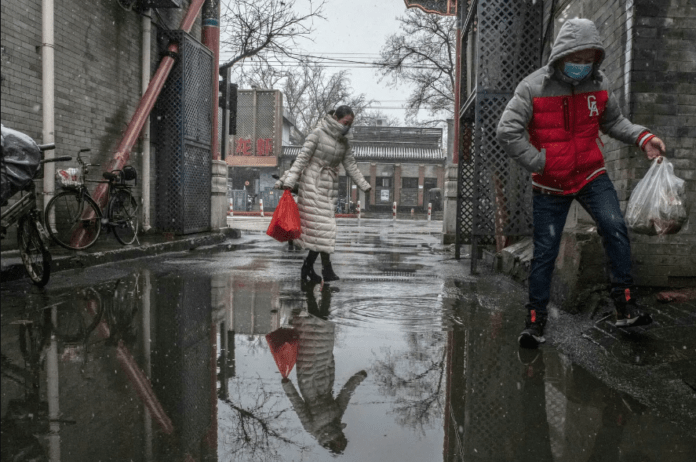
HONG KONG — Chinese officials hailed recent figures as evidence that the spread of the coronavirus epidemic has slowed, and World Health Organization officials said on Tuesday that China’s strict limits on its people’s movements have helped.
But the outbreak and its death toll continue to grow. The picture outside China has grown steadily more alarming. And experts caution against excessive optimism about the crisis peaking.
“It could be unwise for anybody in China, or outside China, to be complacent that this is coming under control at this point in time,” said Prof. Malik Peiris, chief of virology at the University of Hong Kong.
Since Chinese officials first acknowledged the virus in December, it has been hard to judge with precision the severity and scale of the outbreak.
China has changed its criteria for diagnosis, prompting a large increase in reported infections and deaths last week. Tests for the virus have not been very accurate, and people who do not seek or receive medical care may not be counted. And people with mild or no symptoms may not realize they have the virus and may not get counted, either.
Researchers in Germany presented evidence on Tuesday that people who have the new coronavirus can infect others even when they have no symptoms, as disease experts had suspected. Their findings, published in a letter in the New England Journal of Medicine, indicated that people may be spreading the disease before they know they are sick.
But the Chinese government’s daily tally of new infections and deaths from the virus has declined steadily since Feb. 12, a trend that could offer a glimmer of hope if it persists.
On Tuesday, the authorities reported that in the previous 24 hours, 1,886 new cases had been confirmed — the first time since Jan. 30 that the number had dropped below 2,000.
MORE STORIES:
On Wednesday, the number of new infections reported by authorities was again below 2,000, with China recording 1,749 confirmed new cases of coronavirus infection, bringing the country’s total number of reported infections to 74,185.
With 136 deaths reported in Wednesday’s figures, the total number in China of those confirmed to have died from the virus surpassed 2,000, reaching 2,004.
Government officials, as well as public health experts around the world, said the numbers suggested that China’s aggressive measures to contain the epidemic were working. China’s leader, Xi Jinping, told Prime Minister Boris Johnson of Britain in a phone call on Tuesday that China was making “visible progress” in containing the epidemic, according to Chinese state media.
More than half the country’s population is under some limitations on its movements, and 150 million of its people face restrictions on leaving their homes, according to an analysis by The New York Times.
“Right now, the strategic and tactical approach in China is the correct one,” Dr. Michael Ryan, the W.H.O.’s chief of emergency response, said on Tuesday. “You can argue whether these measures are excessive or restrictive on people, but there is an awful lot at stake here in terms of public health — not only the public health of China but of all people in the world.”

China’s lockdown has slowed the spread of the virus from its epicenter, the city of Wuhan, to the rest of China by two to three days, and from China to the rest of the world by two to three weeks, W.H.O. officials said.
The organization’s endorsement of China’s methods was an apparent reversal from less than three weeks earlier, when it had advised against restrictions on travel and trade. Some health experts have condemned the restrictions, saying that they were preventing vital resources from getting where they were needed, and could instill panic.
Prof. Zhong Nanshan, a renowned respiratory disease expert in China, said on Monday that he expected the epidemic to peak in the country’s southern regions by mid- to late February, and the rest of the country to follow soon after.
But Dr. Tedros Adhanom Ghebreyesus, the W.H.O. director general, said on Monday that the apparent tapering of the spread in China “must be interpreted very cautiously.”
“It’s too early to tell if this reported decline will continue,” he said during a news conference in Geneva. “Every scenario is still on the table.”
Initially, the cases reported outside mainland China were mostly among people who had recently visited there, but increasingly, they stem from contact in other countries.
The number of cases in Japan has spiked in recent days, most of them tied to a quarantined cruise ship that turned into a hotbed of transmission. Other case clusters have also turned up in Japan, but so far, the ship, the Diamond Princess, accounts for most of the cases worldwide outside of China — 542 as of Tuesday, an increase of 88 in one day.
On Monday, more than 300 American passengers on the ship were flown to the United States and placed in a two-week quarantine. Fourteen of them tested positive for the coronavirus shortly before leaving Japan, but were still allowed to board the flights. American officials had started the process of evacuating them home without knowing their test results.
Some of those passengers said on Tuesday they had been informed that a few more of them had tested positive for the virus since they arrived in the United States.
Also on Tuesday, the Centers for Disease Control and Prevention told more than 100 Americans who have been on the Diamond Princess they cannot return home for at least two more weeks, after it became clear that efforts to control the virus aboard the ship had been ineffective. The passengers include some who have tested positive for the virus and are hospitalized, and others still aboard the ship who have not shown signs of illness.

Japanese officials said they expected 500 people to be let off the ship on Wednesday. But they did not make it clear how they had concluded it was safe to release people, or how they had decided which passengers would leave, or who those people would be.
Cambodia has allowed more than a thousand passengers from another cruise ship, the Westerdam, to disembark without testing most of them. Hundreds of them flew out of the country, before one of them took ill and tested positive for the virus, raising fears of undetected cases and a further global spread.
The country’s authoritarian leader, Hun Sen, has continued to express complacency about the outbreak, even encouraging passengers from the Westerdam to go sightseeing in Cambodia.
“Cruise ships are the weak link in the containment,” said Prof. Raina MacIntyre, an expert in biosecurity at the University of New South Wales in Australia. Citing the potential for future cruise ships to harbor the virus, she said, “we could lose control of the epidemic if we don’t get a tight handle on the cruise ship situation.”
There are other signs the outbreak’s global toll has not crested. The first coronavirus-related death outside of Asia was announced on Saturday, when a Chinese man died in France. Taiwan announced its first virus-related death on Sunday, marking the fifth fatality outside mainland China.
The economic cost of the outbreak, which has paralyzed China, the world’s second-largest economy, also continues to grow.
On Tuesday, HSBC, the London-based bank with deep roots in Hong Kong, said that it would cut 35,000 jobs over the next three years, in part because of the coronavirus outbreak.

President Moon Jae-in of South Korea warned on Tuesday that the outbreak in China is creating an “emergency” for the economy, saying his country could be one of the hardest hit.
If the virus starts to spread rapidly around the globe, it is unclear how other countries will respond. Few other governments have the power to clamp down as thoroughly as China, or even the desire.
The lockdown in the central Chinese city of Wuhan, where the outbreak started, has taken a heavy human toll, making it difficult for many to find medical care or care for sick loved ones. The countrywide restrictions create their own challenges, stranding employees away from their jobs and pummeling the economy.
“This is the issue,” said Professor Peiris. “It is not clear that this is something that is replicable, even in other parts of China.”
It’s a complicated calculation for China and the world. Though relaxed restrictions could revive the economy and ease fear and frustration, they could also lead to a resurgence of infections.
In recent days, the Chinese authorities, hoping to nudge the economy back to life, have urged migrant laborers to return to work. Hundreds of millions had left urban centers for the Lunar New Year holiday in January.
Officials in the Philippines said on Tuesday that they would allow Filipino migrant workers to return to Hong Kong and Macau, reversing an earlier ban on travel to those regions. (The bar to travel to China remains.)
“The battle’s not over, because the travel restrictions can’t last forever,” Professor MacIntyre said.






